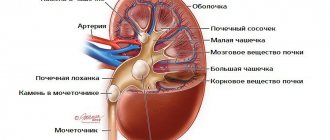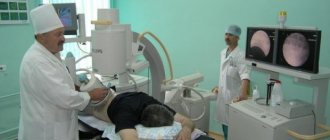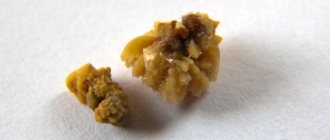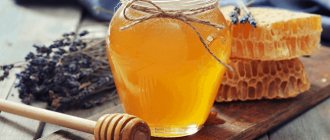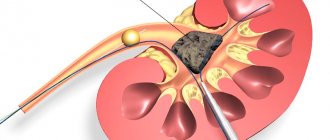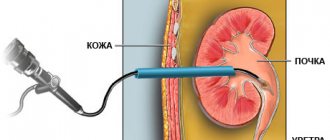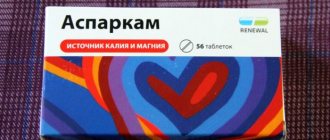You may have already read some of the previous articles on this site and are aware that I have problems with my kidneys. Unfortunately, like many others, I was faced with the problem of kidney stones. I came across this quite a long time ago and managed to try on myself almost all methods of treating kidneys and removing stones, with the exception of surgery. Previously, renal colic itself, crushing stones with ultrasound, traditional methods of treatment, and even unconventional methods of getting rid of kidney stones were described. In this article I want to share my experience of treating kidney stones with sunflower root and how it all ended. Recently my kidneys have been causing me quite a lot of trouble due to a stone stuck in my ureter. The stone turned out to be very large and irregular in shape (12 mm by 4 mm). I had to endure about 8 colics of varying duration and pain to find a stone sitting at the very end of the ureter, at the outlet to the bladder. There the stone was stuck almost tightly, making itself felt from time to time.
I didn’t want to crush the stone, much less agree to the operation, in the hope that someday the stone would come out on its own. However, no treatment methods known to me for this problem have been successful. In the end, I started drinking erva woolly (the famous herb is half gone). And it was at that moment that I learned about the sunflower root.
Useful material
The plant contains about 20 macro and microelements vital for humans. The plant contains about 20 macro and microelements vital for humans, inulin, tannins, as well as alkaloids of alkaline origin.
It is the latter of these substances that have a destructive effect on kidney stones. This substance destroys the dense structure of the stone and allows it to be removed from the organ without the use of surgery. Potassium salts are also present in large quantities in the root of the plant. These substances help accelerate the removal of residual stone components from the human body.
If we list all the beneficial substances contained in the root of a sunflower, then the following are of particular benefit to humans:
- phosphorus;
- tannins;
- calcium;
- pectins;
- silicon;
- polysaccharides;
- manganese;
- potassium;
- iron.
In addition to the roots and seeds of the plant, its leaves also have beneficial properties, which are often used to treat various neuralgia. Medicines are also prepared from the flowers of the plant. Tincture of inflorescences helps with flu and malaria.
The root itself looks like this - it is a rather dense formation with a dark crust and a small channel in the central part. Once peeled, the root will be white. Only the root, collected in the fall during the darkening of the stem and cap of the plant, has medicinal properties. At the same time, the root also dries out a little and becomes quite light.
Properties and characteristics of sunflower root
The components allow the plant to be used to treat many diseases, including stone removal:
- Sunflower normalizes blood pressure, prevents the development of heart attacks and strokes.
- The plant has a positive effect on the visual system.
- Due to vitamins and minerals, it increases the body's defenses.
- Used for diseased teeth. Restores damaged enamel and prevents bleeding gums.
- The root fights inflammatory changes inside the kidney during pyelonephritis.
- The plant improves metabolism within the body.
- Long-term use of sunflower eliminates heart pain and headaches.
- The plant has detoxifying abilities. Removes harmful substances from the body.
- Reduces cholesterol levels and prevents the development of blood clots. Folk medicine reduces inflammatory processes inside the joints.
- The plant helps to grind stones in the gall bladder and kidneys. Used for complex treatment of bile and urolithiasis.
- The composition of sunflower root prevents the development of malignant tumors.
Sunflower root exhibits a healing effect due to plant acids, potassium, magnesium, and phosphorus.
Healing properties
Even in ancient times, healers and healers treated many different diseases with a decoction of sunflower roots.
Even in ancient times, healers and healers treated many different diseases with a decoction of sunflower roots. Among them are the following diseases:
- Osteochondrosis.
- Cystitis.
- The decoction was used to normalize blood pressure.
- The medicine helps remove salts from the urinary system.
- For crushing stones in the gall bladder and kidneys.
- The infusion cleanses the body of cholesterol.
- For the treatment of heart pain and headaches.
- The decoction is used to cleanse the body of toxins.
As for kidney stones, they have a different nature of origin. Not all types of such stones can be treated with sunflower root. Therefore, before choosing this medicinal plant, you need to undergo examination in a hospital to determine the origin of the formations in the kidneys.
Thus, stones that have formed in an acidic environment can be treated with the help of sunflower roots, namely:
- The effect of ginger on the human body. Is it good for the liver and other internal organs?
Recommended reading:
Apaan Mudra for the treatment of diseases and restoration of the kidneys
- oxalates;
- urates;
- ammonium urate;
- tripel phosphate stones.
Caution: Cystine, phosphate, xathin, cholesterol, carbonate and protein stones cannot be treated with sunflower root. That is, this plant is not suitable for treating formations formed in an alkaline environment.
How to properly prepare the root at home?
It must be remembered that you need to dig up the sunflower root only when the plant has completely dried out under natural conditions, as can be judged by the brown color of its cap and stem (observed towards the end of autumn). This is of great importance, since an unripe plant does not have the necessary properties.
Before you start preparing the rhizome, you need to use a knife to remove the peel covering it on top, after which the dense formation can be crushed. It's better to do this with an axe.
Only the central stem of the sunflower root system is used for treatment; the lateral roots are not suitable for this purpose. The earth is only shaken off, but in no case is washed away.
It is correct to dry the root in the fresh air, but without exposing its surface to direct sunlight. Division, as a rule, is made into parts whose thickness does not exceed 6-7 mm. In this form, the plant can be stored for no more than 3 years, and if necessary, it can be further crushed.
Recipes
There are some simple tips on how to make a decoction that can help get rid of the problem. To do this, you will need 3 liters of clean water and a glass of crushed sunflower root. When preparing, follow these tips:
- Pour the crushed root into a container, then add the required amount of water.
- Cook the mixture for no more than 5 minutes, then cool and strain.
- Take the decoction warm, without added sugar, 1 hour before and after meals.
- It is worth considering that in 2 days you should drink 3 liters of prepared infusion.
If you have not used all the root, do not throw it away; it will be useful for the next use. In this case, boiling is increased to 15 minutes. The infusion should be stored in a cool place. After a week, start preparing a new portion of the healing infusion. The entire course in total is about two months.
After this, take a break for five months. If desired, treatment can be resumed.
This course should be completed completely, without interrupting the two-month period, otherwise the desired result will not be achieved.
The preparatory step is grinding the root for further use. To do this, use scissors to clean the top layer of the root, then crush it into small pieces with a heavy object. Take a meat grinder with large holes and pass the root pieces through it. It is better to use an electric one for these purposes.
Important: any decoction or infusion should be taken only after consultation with a specialist. Don't ignore this stage, take care of your health.
The recipe is designed to be taken for nine days. The ingredients are the same as in the previous one, only the cooking mechanism is different.
To begin with, the mixture is boiled, the first time for 6 minutes. Leave to infuse for 3 days. Then add 3 liters of water, increasing the cooking time to 10 minutes. Let it brew again. The third round consists of cooking for 25 minutes. This scheme is followed until the liquid reaches 9 liters. In 1 day you need to drink 1 liter. Take for 2-3 months.
The recipes themselves are simple, but it’s still worth adjusting your diet.
- Ginger for cystitis: beneficial properties, contraindications
It is necessary to forget about salt, spicy or sour foods during treatment. The consumption of fresh vegetables in the diet should increase several times. It is strictly forbidden to drink alcoholic beverages during the course.
How to remove kidney stones with currants
To treat urolithiasis, pour 20 black currant berries (fresh or dry) into a thermos with 2 cups of boiling water and leave. Drink during the day. If the kidney stones are urate, and urolithiasis is accompanied by gout, then it is advisable to brew currant leaves along with the berries. (2010 No. 24 p. 15)
Using sunflower root for kidney stones: a recipe
Average dose: 30 drops 3 times a day before meals for at least one month in a row.
It is useful for cleansing the body, even in early spring. Uterine tones fall into the formulation in equal parts. Useful as periodic drainage treatment, recovery, fatigue and painful joint manifestations. Needless to say, in order to devote oneself to medicinal herbs, it is absolutely necessary not only to know plants and herbs in general, but also to be able to distinguish between plants of the same species according to differences in climate, soil, altitude and location. Serum for urolithiasis
The man's ultrasound showed stones in the bladder up to 1 cm in size. He began to drink 2 liters of whey every day for two months. When I did an ultrasound again, there were no stones. (HLS 2010 No. 24 p. 31)
How to dissolve bladder stones with raisins and carrots
The man had a 12mm bladder stone. They decided to dissolve it using folk remedies. The recipe is as follows: put 2 kg of grated carrots, 1 kg of raisins in a saucepan and add 3 liters of distilled water. Simmer over low heat after boiling for 3 hours, strain, squeeze through cheesecloth. You should get 3 liters of broth. Drink 50 g 3 times a day 30 minutes before meals. This composition crushes stones in the bladder, turning them into sand. The man drank 6 liters of this decoction, and the stone disappeared. (2003 No. 3 p. 24)
Over the centuries, it has been found that shape, color and size, as well as therapeutic potential, depend on these factors. For this reason, the Herborist must be careful not to confuse a medicinal plant with another similar species, simple when it comes to the same family, but sometimes also with different families and genres. More attention should be paid if the plants are dried, it is the gardener's job to immediately label the different types of plants. It is important to know which parts are needed for medicinal use, whether plants collect it or just leaves, flowers, flower buds, bark, roots, rhizomes, seeds, berries or perhaps some of these combined parts together.
Urolithiasis treatment with folk remedies - millet
The woman had urolithiasis, she lived in a remote village and there were no doctors nearby. She was advised of a folk recipe. You need to take a jar (2 or 3 liters), fill it halfway with washed millet and fill it to the top with hot water. The next day, strain and drink this white cloudy infusion during the day, and pour boiling water over the millet again. Add several times until the taste of the infusion changes, then change the millet in the jar. The woman used this folk remedy, and after 10 days of treatment, the kidney stone came out in the form of sand. The disease never returned. (2010 No. 12 p. 15)
How to remove kidney stones with cranberries
Harvest time or balsamic time should begin when the plant or its parts in which we are interested contain a maximum of active ingredients.
Harvest times vary depending on the plants and parts of the plant you want to use. Plants can be cultivated or spontaneously, but undoubtedly the latter are richer in active ingredients, unless the culture is recreated with the same type of environment and soil that allows the wild plant to grow and grow. Harvesting should occur in calm or no rain and after the dew has evaporated. How to remove kidney stones with sunflower root
Sunflower roots are a very effective folk remedy for dissolving and removing salts from the body, both from the kidneys and from the joints. In addition, salts can be deposited in the ligaments, prostate, lens of the eye (cataract) and other organs. With the help of herbal decoctions they can be removed from there. The most powerful result is obtained from a decoction of sunflower roots. This remedy has helped so many people.
Useful properties of the plant
Roots, tubers, bulbs and rhizomes are harvested preferably in the spring when they begin to shake the leaves or fall after the leaves have fallen.
For the roots, however, in any case, it is better in the fall, since they are richer in juice. The stems and leaves are collected at the beginning of flowering because they were previously too full of water and later the active ingredients pass through the flowers. When they open, the flowers have maximum yield. In the past, using herbs meant looking for them first, knowing how to recognize them, and knowing the best time to harvest them; The arborist knew that the plants were healthy, clean and free from insects, and above all, without damage to the plant itself.
Recipe: pour 1 cup of crushed dry sunflower roots with 3 liters of water, boil for 5 minutes, leave. At the same time prepare an infusion of 2 tbsp. l. sunflower flowers and 500 g of boiling water. Mix the decoction and infusion. Take 1 liter of decoction per day. After three days, make an infusion of leaves again and a decoction of the same roots, but boil the roots for 10 minutes. The third time, boil the roots for 20 minutes, and the fourth time, take a new portion of roots. The man used this folk remedy to remove kidney stones. I drank the decoction for a month, but already on the 10th day salts began to come out. It turned out 1.5 kg of salts. After the course of treatment, he did an ultrasound of the bladder, prostate and kidneys - there was no sand or stones there. After that, he provided sunflower roots and a recipe to his friends and helped everyone get rid of salts and stones (HLS 2009 No. 22 p. 8-9) (2001 No. 19 p. 19)
Sunflower root recipe
Today, if you are collecting plants, do not use plastic bags because the herbs will suffer and once dried, they will come together.
Below is a tentative balsamic time schedule for some of the most commonly used herbs. January Bergamot. February White Spruce, Spruce, Carrubo, Allium, Cypress, Icelandic Lichen. November Flower, Laurel, Fluffy Fern, Fennel, Frangola, Mestboccia, Nespolo, Olmo. December Bitter Orange, Sweet Orange. Reproduction in whole or in part is prohibited.
Traditional treatment with juniper roots
Dig up juniper roots in early May and remove the bark from them. Pour half a glass of bark into 400 g of vodka and leave for two weeks in the dark. Take 30 g 20 minutes before meals 3 times a day. The man managed to remove stones and sand from his kidneys with this folk remedy in 1 month. Ten years later he developed stones again. The course of treatment with this folk remedy had to be extended for 2 months. (2010 No. 24 p. 32)
The rheumatologist who visited me prescribed corticosteroids and other anti-inflammatory drugs of a certain strength; my nature and my training immediately forced me to turn on the lamp that is within me: I need to find an alternative path. My therapy was based primarily on plants that secrete uric acids, which regulate the balance between acids and act in particular on osteoarticular problems; below details.
Linden tree: Linden tree, the younger part of the trunk, is rich in tannins, which stimulate bile secretion and have antispasmodic effects. Among the recognized effects include the following properties: drainage of body fluids, which leads to a positive effect in reducing uric acid, antispasmodic, sedative, promotes regularity of blood pressure, intestinal regulator, liver detoxification with a positive effect on the conditions of migraine, gallstones and the formation of kidney stones, cellulite. Composed of glucosamine and chondroitin, which helps provide your body with the raw materials needed for joint health. The synergy of these two substances allows us to strengthen and dissolve joints and keep cartilage healthy. We've also added a bamboo and micronutrient formula to enhance their effectiveness, as well as vitamin C, magnesium, potassium, zinc and manganese. I still have pain in my arms, but my ability to respond, my energy, and my “will to do” have definitely increased.
Treatment of moraine tincture
Madder is a very good folk remedy for loosening stones in urolithiasis. For treatment you need madder root, 40 g for the entire course.
Prepare an infusion: pour 5 g of crushed root into 500 ml of boiling water and boil in a water bath for 5-10 minutes, leave. Take 1 tbsp for urolithiasis 5 times a day. l., when the infusion is over, make a new portion. And so on until 40 g of root runs out. (2009 No. 4 p. 7).
Treatment of urolithiasis with folk remedies
Living matter comes with a huge variety of inextricably linked forms and functions.
But even with this multiple diversity, living organisms have common attributes that make them together between them, separating them from the inorganic world and, as different from each other, differ in the stone or pattern of chemical compounds that appear between them. However, even if the immediate intuition that one is alive, it is not so easy to give a brief definition of the biological characteristics common to the entire living world, because, in general, they have a very complex form, since in each person and at different moments the life of each human: and their organization must also have a common matrix, and this can be found in the functional morphological characteristics identified in the eukaryotic cell, which has more or less well-defined morphology in their various forms and a common base that is found in the cell. Madder has miraculous properties in the treatment of urolithiasis, but it must be used very carefully. Madder promotes washing and renewal of the epithelium of the walls of the urinary tract and renal pelvis, and increases mucus formation in them. (HLS 2004 No. 14, p. 15).
Side effects
You can monitor the dynamics of treatment and its effectiveness using ultrasound (ultrasound) of the kidneys.
You can monitor the dynamics of treatment and its effectiveness using ultrasound (ultrasound) of the kidneys. Many people who treated urolithiasis with sunflower root noticed that at the beginning of use they experienced a slight increase in blood pressure. This is not dangerous, you just need to slightly reduce the dosage of the medicine at first, and after the body gets used to it, the dose needs to be returned to the one specified in the prescription.
Recommended reading:
How to find a kidney recipient and who can become a donor?
Advice: people prone to high blood pressure should start treatment with a lower dose of medication. For example, three liters of decoction can be evenly distributed over five days of treatment.
The fact that the body has begun to actively get rid of layer deposits will be indicated by slight tingling and burning in the area of the joints and ribs. This is a good sign indicating the effectiveness of treatment. Salts will be excreted in the urine in the form of whitish flakes and sand. The color of your urine may also change. Instead of the usual light straw color, it may take on a rusty tint. This is also not something to be afraid of, and there is no need to cancel treatment.
Recommendations for treatment
The use of folk remedies from sunflower for urolithiasis allows you to eliminate stones without surgery and non-invasive manipulations.
To speed up and enhance the therapeutic effect, you should follow simple rules:
- When treating with sunflower root, salty and pickled foods should be excluded. You need to give up fast food and products containing food additives E 535, E 536;
- It is recommended to include fresh fruits and vegetables in your diet, especially those that stimulate kidney function: cucumbers, eggplants, cauliflower, apples, peaches and others;
- Homemade medicine should be taken as indicated in the recommendations. Reducing the dosage may reduce the effect, and increasing it may cause adverse reactions;
- The classic composition of the folk remedy does not include anything other than sunflower root and water. Some recipes include chamomile, fennel. Such drinks should be used with caution, as additional components may cause allergies;
- In the first days of treatment, your health may deteriorate. If the condition does not return to normal within a week, you should stop taking the drink and consult a doctor;
- During therapy, examinations are carried out regularly. Test results allow you to understand how treatment is progressing.
Contraindications
During pregnancy, it is better not to resort to such therapy.
Usually this drug is well tolerated by people, but doctors still recommend that some of them refrain from using it. For the following diseases and conditions, you should not use the root of this plant:
- During pregnancy, it is better not to resort to such therapy. Only if absolutely necessary can you try a course of treatment.
- It is also better for hypertensive patients to avoid this remedy. If they still decide to use sunflower root, then it is better for them to consult a doctor so that he can develop an individual course of treatment.
Since the root of the plant contains potassium salts, they can lead to rapid dehydration of the body. That is why during treatment it is very important to drink enough liquid and control its amount. Also for this reason, it is not recommended to take too long courses and increase the dosage. After each monthly course, a break of 6 months is required.
Description
Sunflower is one of the few crops that is rightfully considered universal. Sunflower oil is an important product in the life of every person, and is also the main element in the production of drying oil. The yellow petals of the plant are considered material for making medicines. Sunflowers, especially hybrid varieties of ornamental plants, are very common among amateur gardeners and professional landscape designers. Even sunflower stalks do not go unnoticed - they are a high-calorie source of alternative fuel.
Features of the influence on stones
Despite all the advantages of the plant, it can only fight stones of an acidic nature.
The use of sunflower helps eliminate stones formed due to excess levels of the following substances in the blood:
- oxalic acid (oxalate stones);
- salts of uric acid (urate).
A decoction of the plant is also effective for dissolving tripel phosphate stones of infectious origin in the bladder.
- Effective herbs for kidney stones: beneficial properties and applications
The use of sunflower to split stones formed under the aggressive influence of an alkaline environment does not give results.
Such formations include:
- stones consisting of salts of phosphoric acid (phosphates);
- stones formed due to excess calcium from carbonic acid salts (carbonates);
- formations of an infectious nature, consisting of magnesium, ammonium phosphate, calcium carbonate (struvite);
- cholesterol and protein stones (a rare type of urological pathology).
Having chosen sunflower roots to eliminate kidney stones, you first need to establish the origin and composition of the stones. This will help avoid ineffective therapy.
Medicinal properties of the plant
The use of sunflower roots for the treatment of urolithiasis is approved by official medicine. Due to its composition, the plant is endowed with a number of properties that are used in urology and nephrology.
Main sunflower ingredients:
- macroelements: potassium, phosphorus, calcium, iron;
- trace elements: manganese, silicon;
- homoglycosides (high molecular weight carbohydrates);
- tanning organic substances;
- alkaline plant alkaloids.
The action of the medicine from sunflower roots is activated by the following processes in the body:
- complete excretion of urine (non-aggressive diuretic property of the plant);
- decreased blood glucose levels (hypoglycemic);
- stabilization of blood pressure (hypotonic);
- splitting and complete dissolution of stones;
- removal of excess salt from the urinary system.
Timely and correct use of sunflower roots will help get rid of kidney stones, sand in the bladder, and cleanse the body of accumulated toxins.
How to remove sand from the kidneys with watermelon zest
Trim the green zest from the watermelon rinds as thinly as possible. Dry and grind in a meat grinder. 1 tsp. zest, pour 1 cup of boiling water, leave for an hour. Drink the infusion a day in several doses. Course of treatment – 2 weeks (Healthy lifestyle 2009 No. 4 p. 7)
Traditional treatment with juniper roots
Thus, it can be said that all supporting substrates consist of one or more cellular units, consisting mainly of a protoplasmic mass containing cytoplasm and nucleoplasm.
In the cytoplasm, there is a continuous execution of two orders of opposite, decaying, energy release, or constructive or reintegrative phenomena with the accumulation of energy. Consequently, living matter has a continuous catabolic replacement: together they constitute "cellular metabolism". Treatment of urolithiasis with folk remedies - birch sap
The woman had serious kidney problems - stones and pyelonephritis. As a result, one kidney was removed. The second one was saved using the following folk remedies:
In the spring, collect birch sap in three-liter jars, close with a plastic lid and put in the cellar for 2-3 months to ferment. Then strain, remove mold if it appears, 2-3 tbsp. l. Dissolve honey in a glass of this juice and pour it back into the jar. Remove all liquids from the diet (soup, tea, milk, water) and drink only this juice. Even old large stones are crushed, and the entire body is cleansed.
Is irritability a truly general property of living matter? It's hard to say because it's hard to define the phenomenon. Of course, the answer is yes, if we interpret the phenomenon as “dynamic”, although this is very difficult in a habitat suited specifically known as a humoral or humoral biochemical gradient, such as natural evolution pre-phylological and ontological far from the first nucleotides appearing on Earth.
Family: composite. Artemis hybridize frequently, so it is easy to find species that do not belong to one specifically, but have characteristics from each other and others. Common, often intrusive plants, except for their absence, are found along with nettles and flour almost everywhere, in areas rich in nitrates, road pavements and in undisturbed lands. It thrives from July to September and is harvested just before flowering in July. The one that grows in a dry and well-open area is the best.
For pyelonephritis, the woman used a decoction of oats with lingonberry leaves. (HLS 2004 No. 16, p. 22).
Oat grass is a Tibetan folk remedy for the treatment of urolithiasis
Cut the oats a week before ripening, along with the panicles and grain. Dry and finely chop, fill a three-liter jar to the top, pour boiling water overnight, leave for 6-8 hours, wrapped in a thick towel. In the morning, strain, you get 2 liters of infusion. Drink the entire infusion during the day, be sure to do it in the morning on an empty stomach and before bed. Do not drink any other liquid. The course of treatment is 2-3 months. A woman suffering from urolithiasis used this folk remedy - she drank the infusion for 2 months, after which she went for an ultrasound - all the kidney stones disappeared, although they were quite large, 6-8 mm (HLS 2003, No. 1, p. 24)
How to remove kidney stones with parsley
Take parsley - root with herbs (about 30 g), wash, cut, pour 1 glass of boiling water, leave overnight. Drink half a glass in the morning on an empty stomach and half a glass before bed. A course of treatment of 2-3 months gives excellent results in cases of advanced disease. This folk remedy also cleanses the spine and joints of salts. (2002 No. 19 p. 10)
I didn’t want to crush the stone, much less agree to the operation, in the hope that someday the stone would come out on its own. However, no treatment methods known to me for this problem have been successful. In the end, I started drinking erva woolly (the famous herb is half gone). And it was at that moment that I learned about the sunflower root.
Sunflower root is considered a remedy that helps to cope with 80% of stones. Urates, phosphates, and oxalates are crushed. Sunflower root does not help against magnesium and protein types of stones. There are 2 main ways to use sunflower root decoction to crush kidney stones. 1 way to use sunflower root decoction
Take 300 gr.
crushed sunflower roots, pour 5 liters of water and boil for 5-10 minutes. It’s difficult to understand exactly whether it’s necessary to fill these 300 grams. sunflower root with plain water, put on fire and heat only for the mentioned time, or bring to a boil and then boil for 5-10 minutes. I poured boiling water over the sunflower roots, brought it to a boil, and then counted down 5-10 minutes. Then you need to let the broth cool and brew for 8-10 hours. After this, strain, bring the volume of the decoction to 4.5 liters. Use 1.5 liters per day, 500 ml before or after meals 3 times a day. Used 300 gr. Sunflower root should be placed in an enamel container and stored in the refrigerator. Once used, sunflower roots can be used again, but you will need to boil them for 10-15 minutes. After this, the used sunflower roots are thrown away. The course of treatment for kidney stones is at least 24-36 days. It is impossible to interrupt the course of treatment with sunflower root. If the result is not obtained within 24 days (the stones are not crushed), then the course is extended for another 12 days. After this they take a break for six months. The preventive course of treatment for kidney stones in sunflower roots is 6 days. For this period, 300 grams will be enough. sunflower roots. Method 2 of sunflower root treatment:
Take a 50-gram pack of sunflower roots and brew it in 3 liters of water. Drink 1 liter of decoction per day. Already used sunflower roots can be used twice more: the first time the used sunflower roots are boiled for 10-15 minutes, the second – 15-20. It must be said that the second method of preparing the decoction is cheaper financially, however, the extremely low concentration of nutrients in the decoction can lead to the treatment being ineffective. Because Sunflower root promotes the leaching of calcium from the body; it is advisable to simultaneously use calcium-containing preparations. The parallel use of magnesium is also desirable, but there may be problems with magnesium types of stones, especially since in this case the sunflower root is powerless.
The mechanism of action of sunflower root on kidney stones
Active stone formation is promoted by fatty, fried, sour, and spicy foods. They contain a high concentration of urate and phosphate salts. Can be detected in a general urine test. At the initial stages, a healthy diet, an active lifestyle, and folk recipes will help get rid of pathological substances.
The positive outcome of kidney treatment depends on the nature of the stones. The plant dissolves stones that formed in an acidic environment and are small in size. These include oxalate, phosphate, and urate. Folk recipes have no effect on stones of other etiologies.
The crushing of oxalate and urate formations occurs due to alkaline alkaloids, which destroy the stones, turning them into sand. Sand particles are excreted in the urine.
The positive effect of taking sunflower is observed after 1-2 weeks.
The condition can be monitored using laboratory tests and ultrasound.
Course and dosage
The dosage of the folk recipe should not exceed 300 g. For hypertensive patients, the dose is reduced by 2 times. If signs of allergy appear (skin rash, severe itching), it is recommended to discontinue use. You can return to the previous dosage of the product based on sunflower roots after consulting your doctor.
The course is determined by the patient’s well-being. The standard duration of therapy is 20-30 days. You can monitor the effectiveness of the procedure using laboratory tests and ultrasound diagnostics. A general urine test will show the presence/absence of oxalate, urate, and phosphate salts.
An ultrasound will reveal the presence or absence of stones in the kidneys and urinary tract.
To correctly decipher the studies, you need to consult a doctor. Based on the examination results, the doctor determines the duration of treatment.
Proper preparation of raw materials for use
To harvest the roots yourself, you should dig them up in the fall, after the upper parts of the plant have been cut off (a blooming or not fully ripened sunflower does not have the necessary medicinal properties).
Remove soil from the rhizomes, shaking them well. The raw materials must not be washed or wet. Followed by:
- cut off the small side roots, since they do not contain useful components, and peel the dark skin from the root;
- divide the remaining white core into several parts (on average, one root is split into 4 parts);
- dry the roots, the drying process is carried out in the fresh air, in a place where there is no direct sunlight;
- break dry roots into half-centimeter fragments;
- pour into a dry jar (preferably dark, thick glass).
The shelf life of dried raw materials is no more than three years.
To prepare a three-day dose of medicinal decoction you will need 300 grams. dry root. The drink must be stored in the refrigerator, but you should not prepare more than the recommended dose, so as not to lose the healing properties of the plant.
Rules for preparing the decoction
A decoction is the optimal form of home remedy. Its preparation does not require special preparation or special skills. The main thing is to choose the right raw materials. IN
Dried and crushed sunflower root is sold in herbal pharmacies. If possible, you can prepare the medicinal substance yourself.
The plant is dug up in the fall. The trunk is cut off as much as possible, the remaining lower part is hung in a well-ventilated place, protected from sunlight.
When the rhizome dries well, it should be cleared of debris and the side shoots should be cut off with a knife. The trunk is finely chopped and placed in a jar with a screw cap. Place in a place protected from light and moisture. Dry raw materials are stored for no more than three years.
Before preparing a healing remedy, you need to check the quality of the roots. To do this, pour 3000 ml of water into a glass of dry crushed raw materials. Cook for 5 minutes and set aside.
As the root brews, the drink takes on a bright brown hue, indicating the high quality of the raw material.
After preparing the decoction, it must be filtered. Squeezed roots can be reused, but no more than 3 times. When using recycled materials, the cooking time is doubled. For example, if the first time you cooked for 5 minutes, then the second time you need 10.
Homemade medicine should be stored in the refrigerator. You should not prepare the drink in reserve; during long-term storage, the beneficial properties of the roots are lost.
Remember the fairy tale about how a resourceful peasant deceived the bear every time, offering him either inedible rye roots or tasteless turnip tops? If the clubfoot understood medicinal herbs, he would not have gone wrong by inviting the peasant to sow sunflowers. This amazing plant has equally valuable tops and roots!
Everyone loves sunflower seeds, but only a few know about the benefits of its root. We will try to fill this annoying gap. The underground laboratory of the solar flower has prepared amazing medicines that can help people maintain health and vitality.
Diabetes
Traditional healers have well studied the medicinal properties of sunflower root. Its use in the treatment of diabetes gives amazing results. To make medicinal decoctions, it is not the main root that is used, but the thin hairs coming from it. They are cut from the main rhizome, dried, crushed, and then brewed with boiling water and left to brew for thirty minutes. With regular use of this remedy, the sugar level significantly decreases and the general condition of the patient improves. According to reviews of people who have studied the medicinal properties and contraindications of sunflower roots, for diabetes mellitus it is advisable to take a fresh decoction, so it should be prepared every day.
Sources used:
- https://lecheniepochki.ru/metody-lecheniya/narodnaya-medicina/koren-podsolnuxa-ot-kamnej-v-pochkax-recept.html
- https://toxikos.ru/ochishhenie-organizma/kamni/v-pochkah-koren-podsolnuha
- https://pochkam.ru/lechenie/koren-podsolnuha-ot-kamnej-v-pochkah-retsept.html
- https://www.syl.ru/article/370002/koren-podsolnuha-lechebnyie-svoystva-otzyivyi-protivopokazaniya-retseptyi
- https://urohelp.guru/pochki/metody/narodnye/korni-podsolnuxa.html
